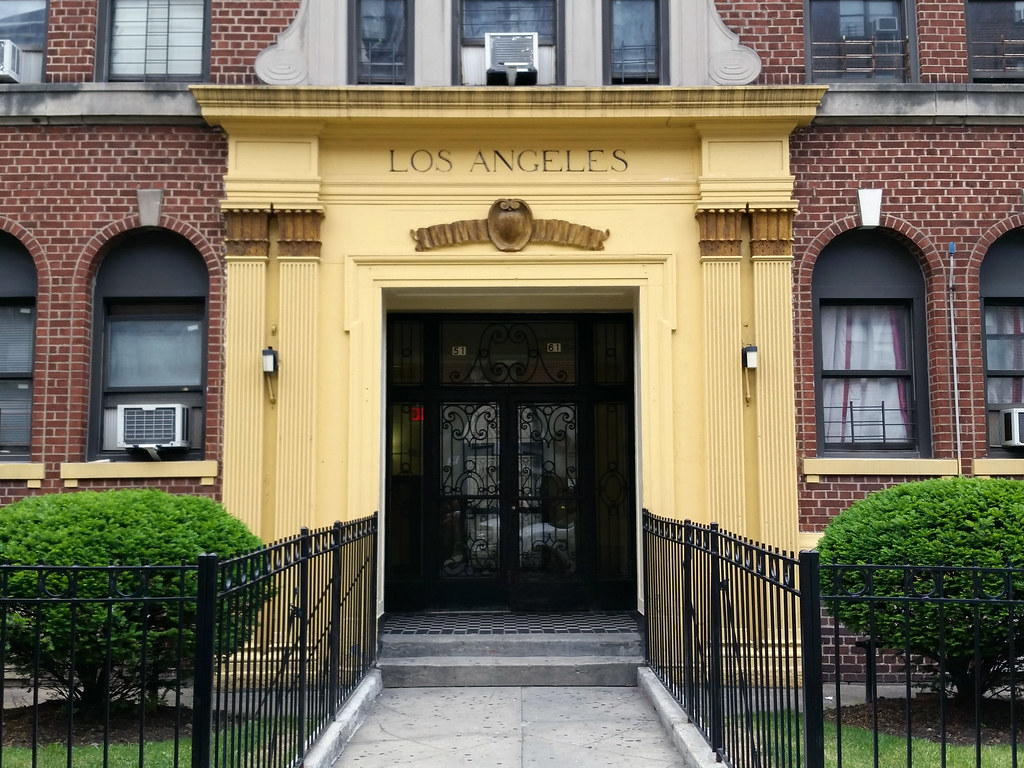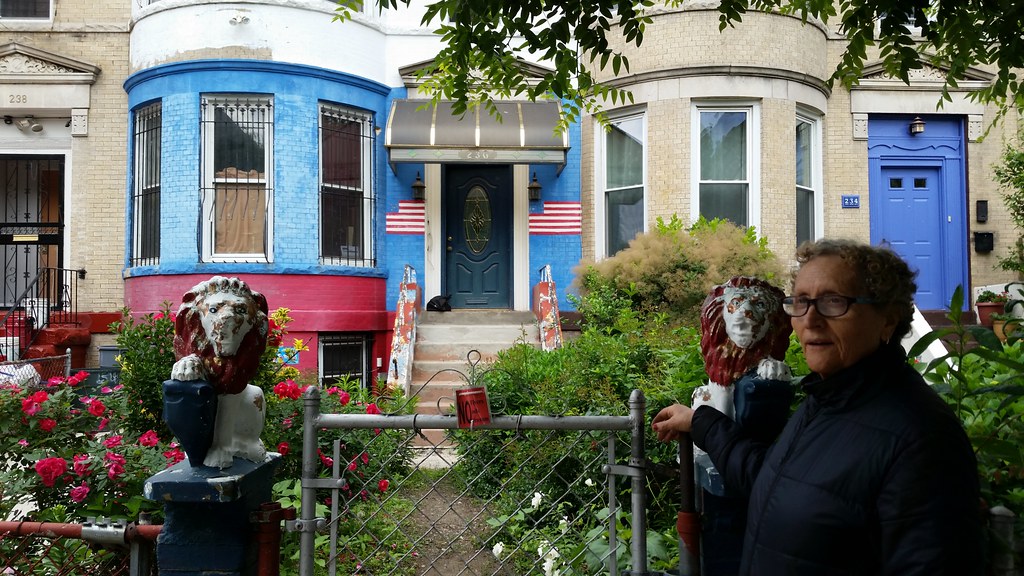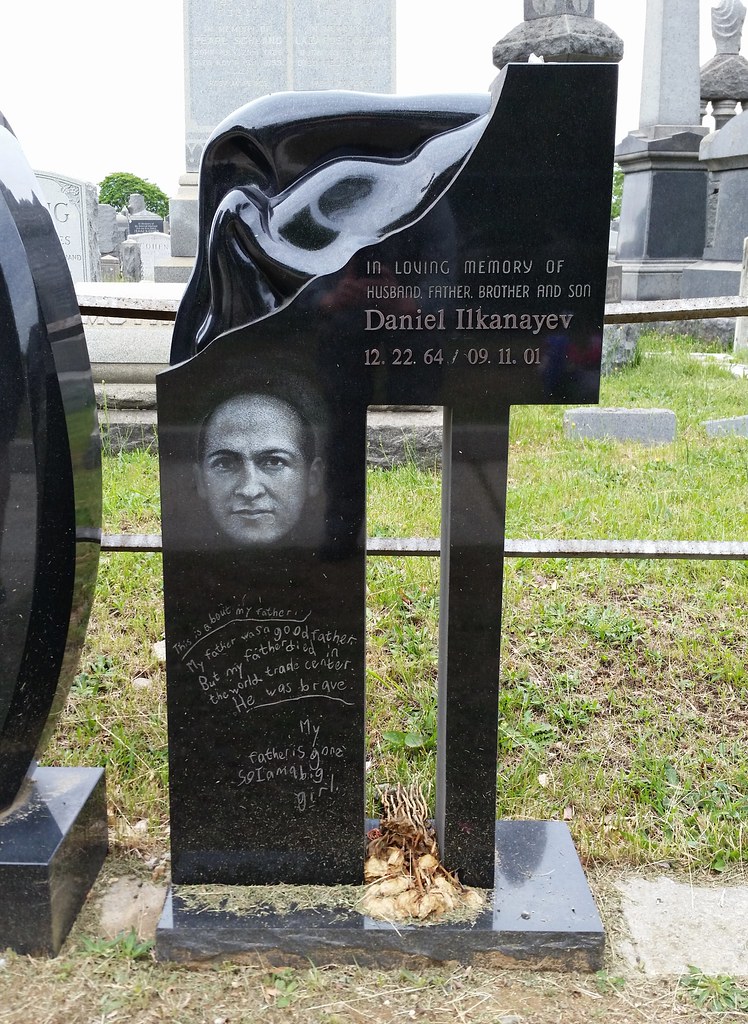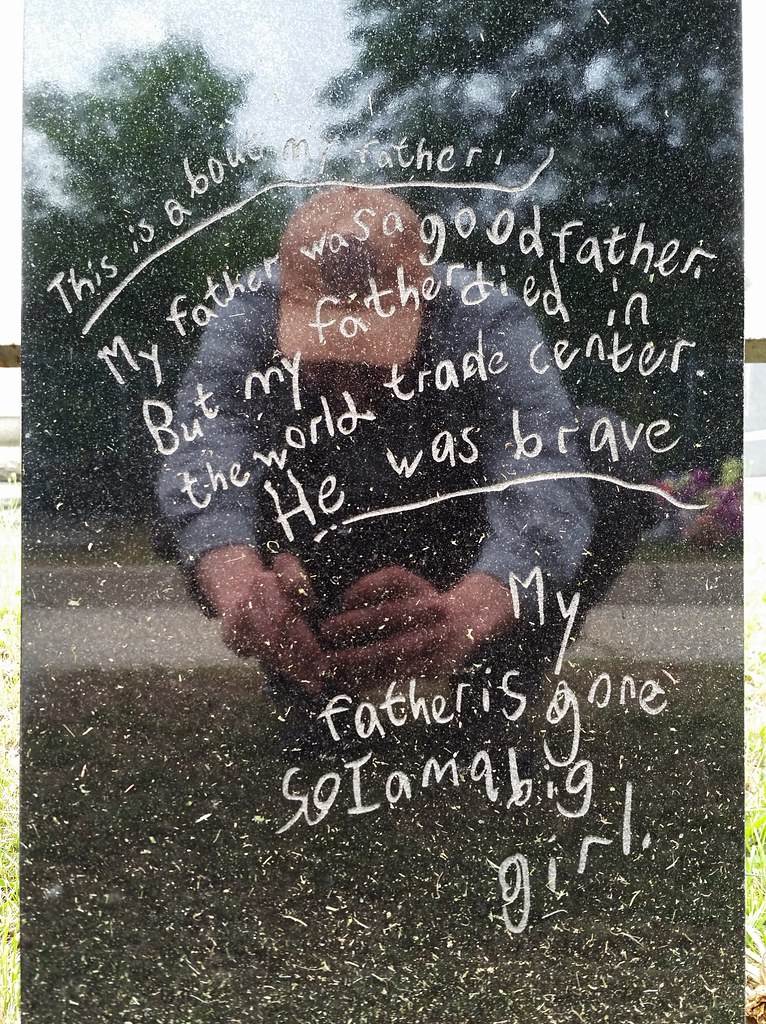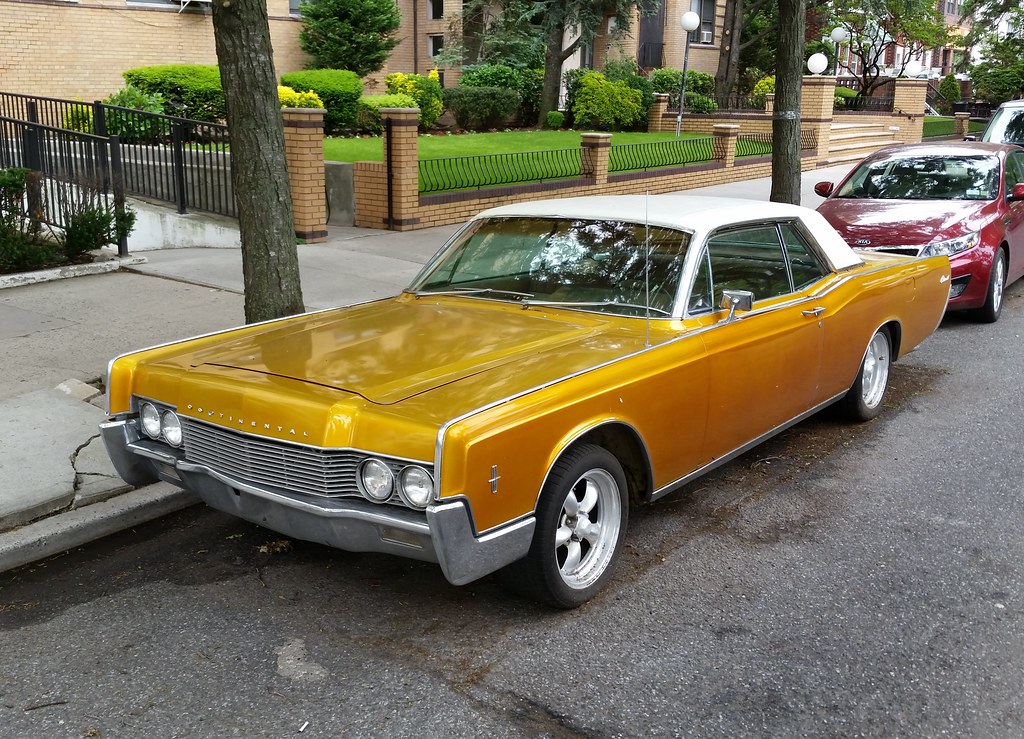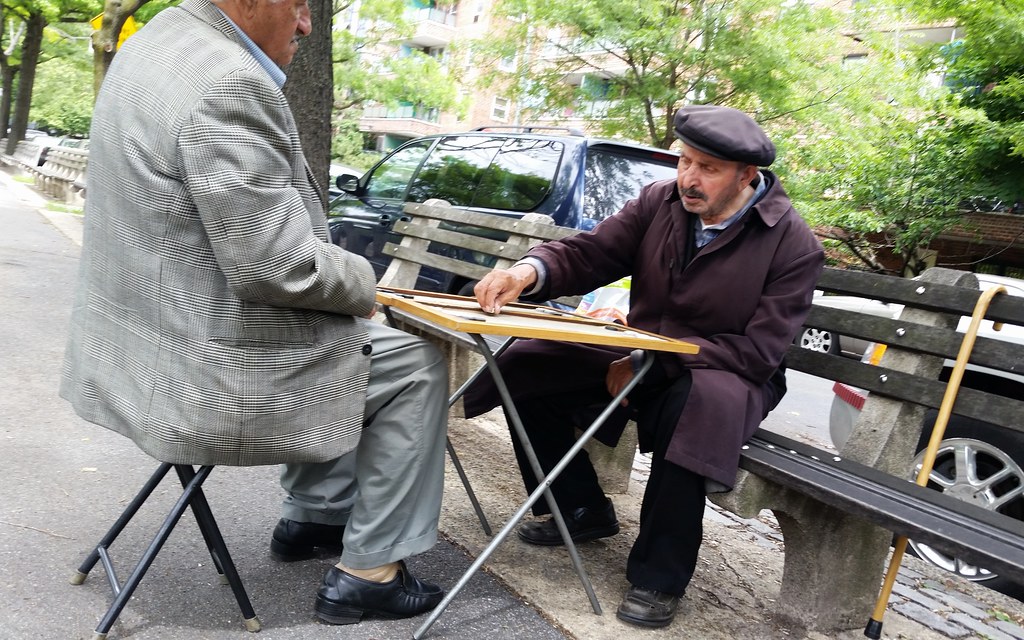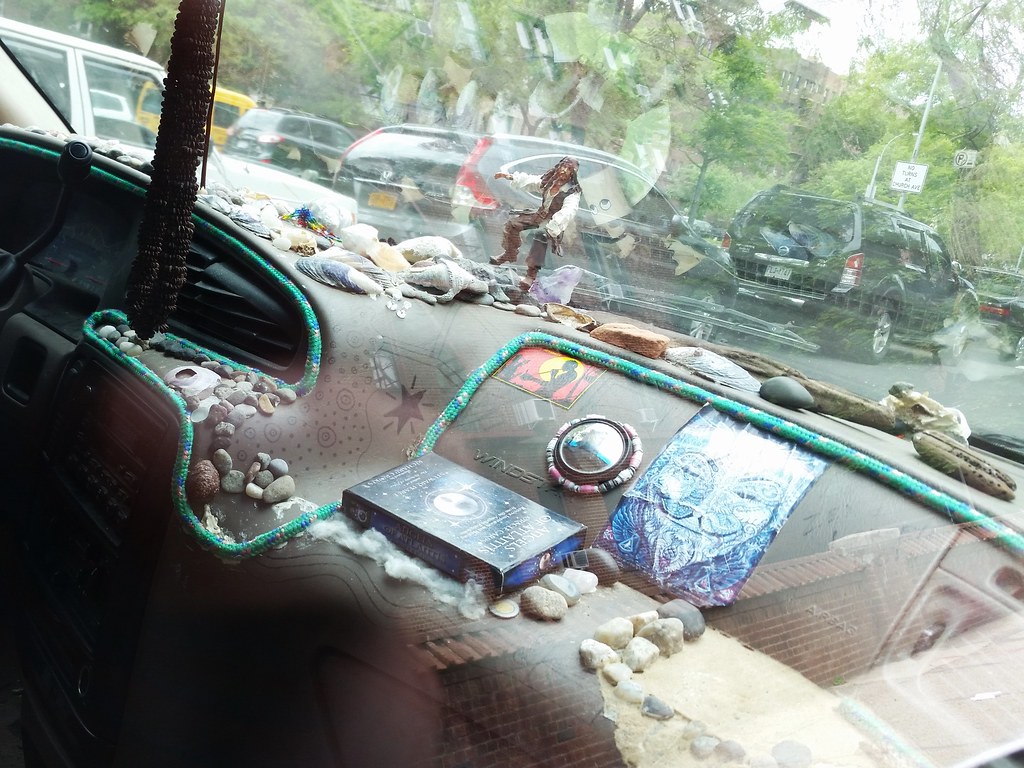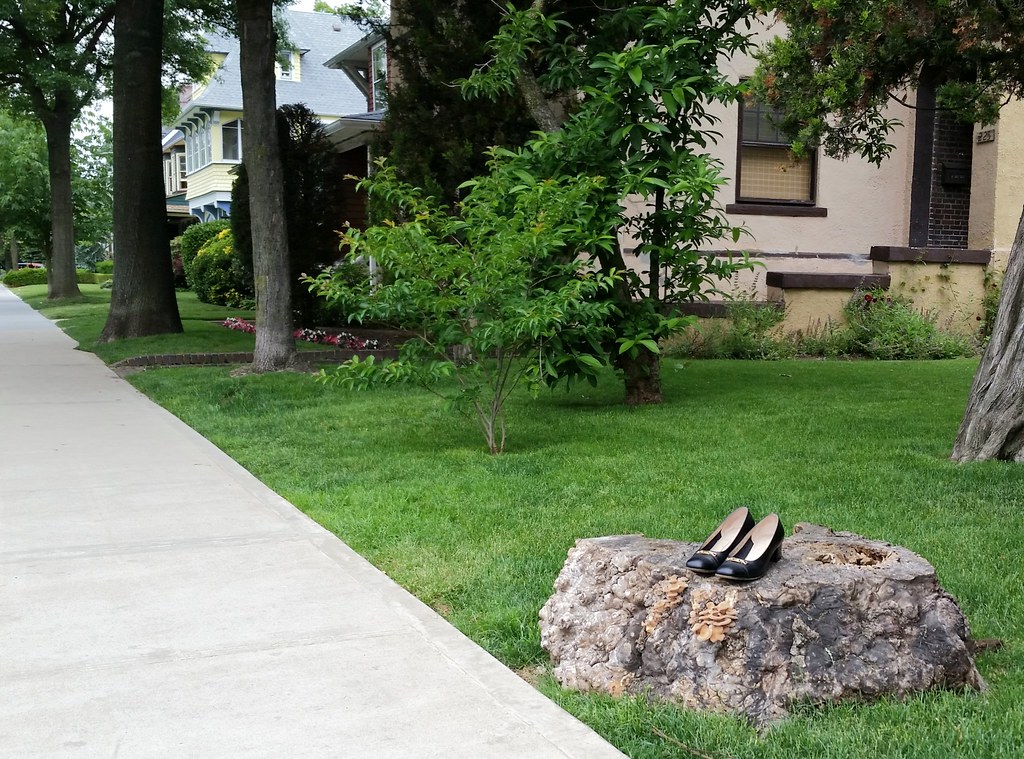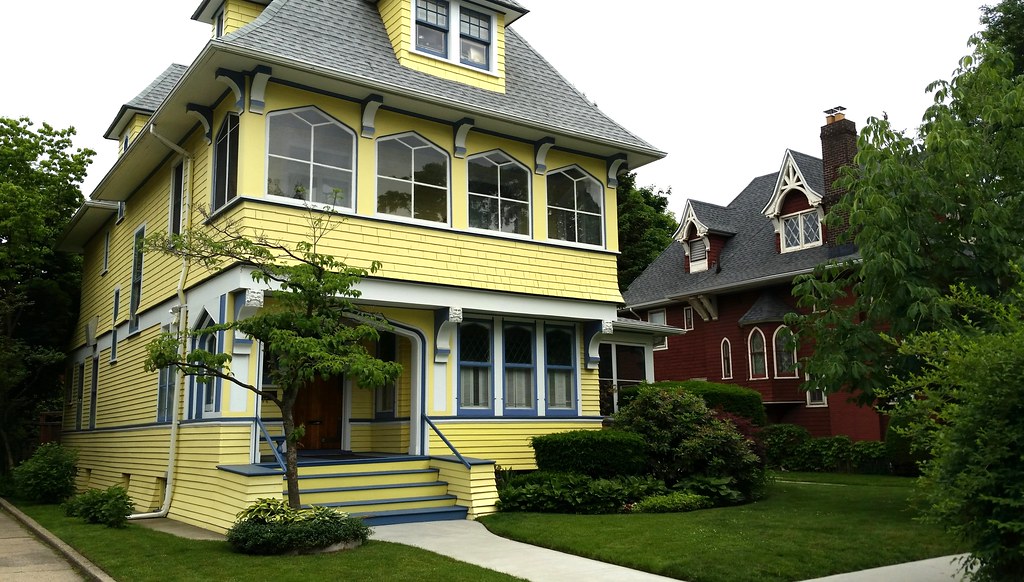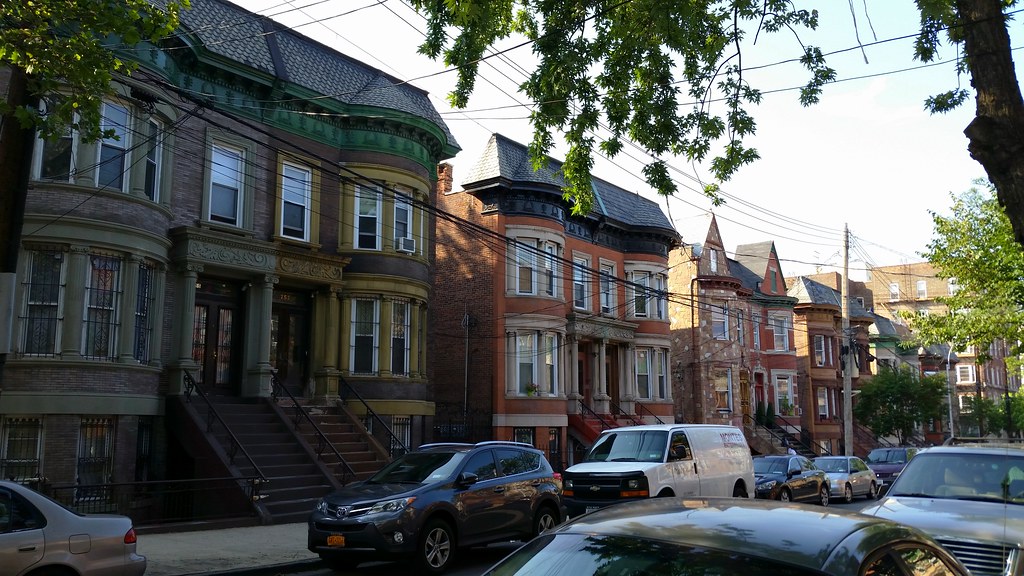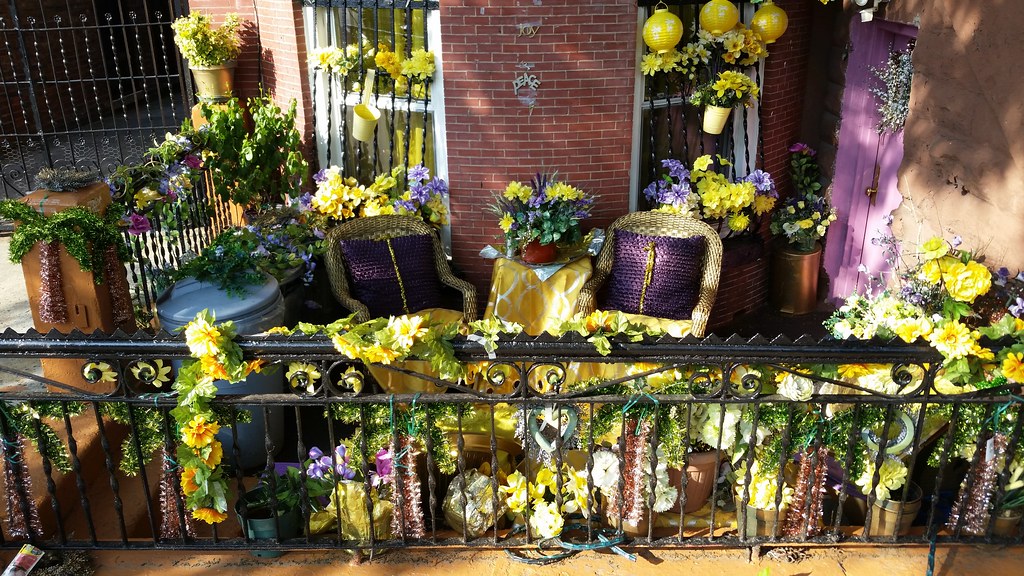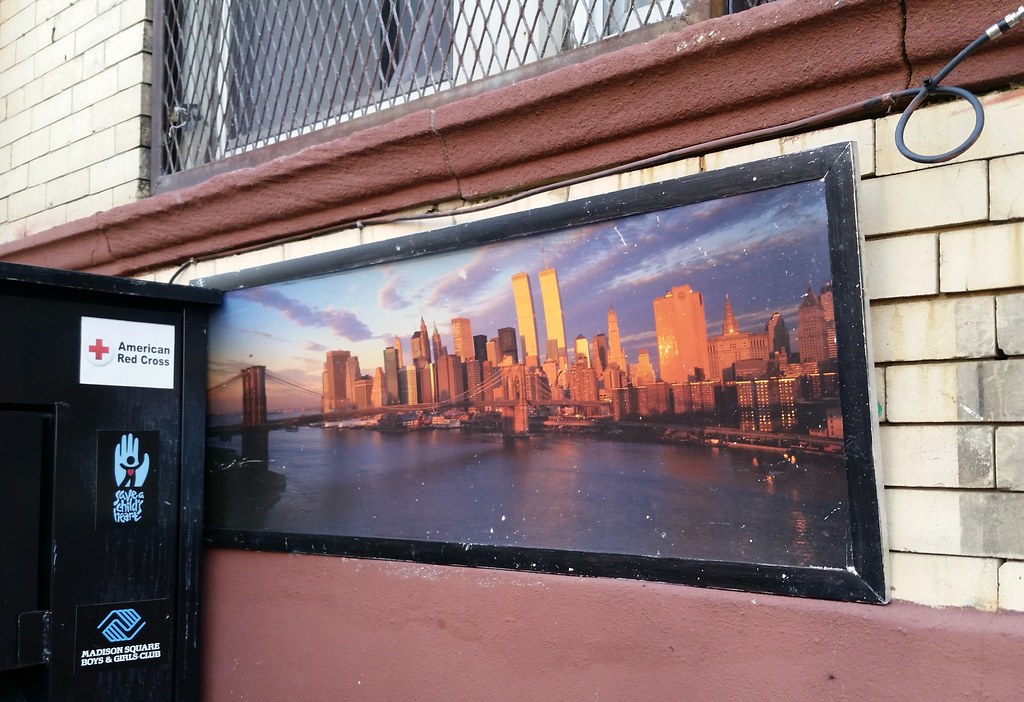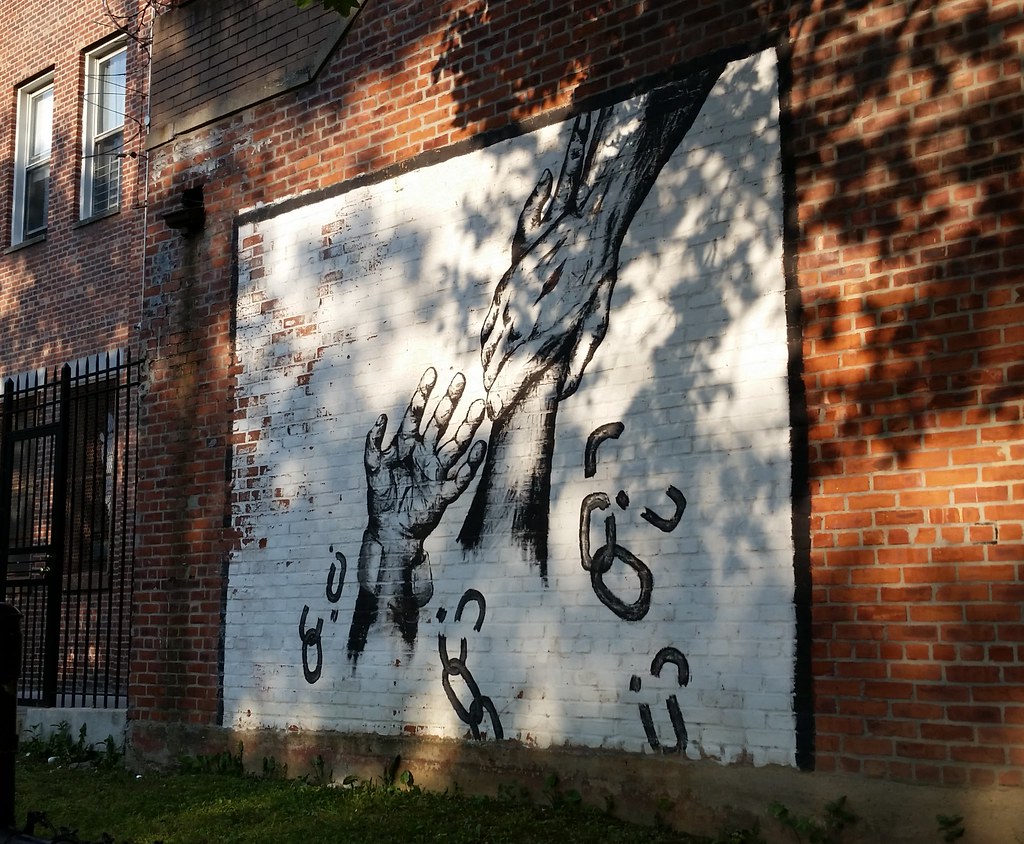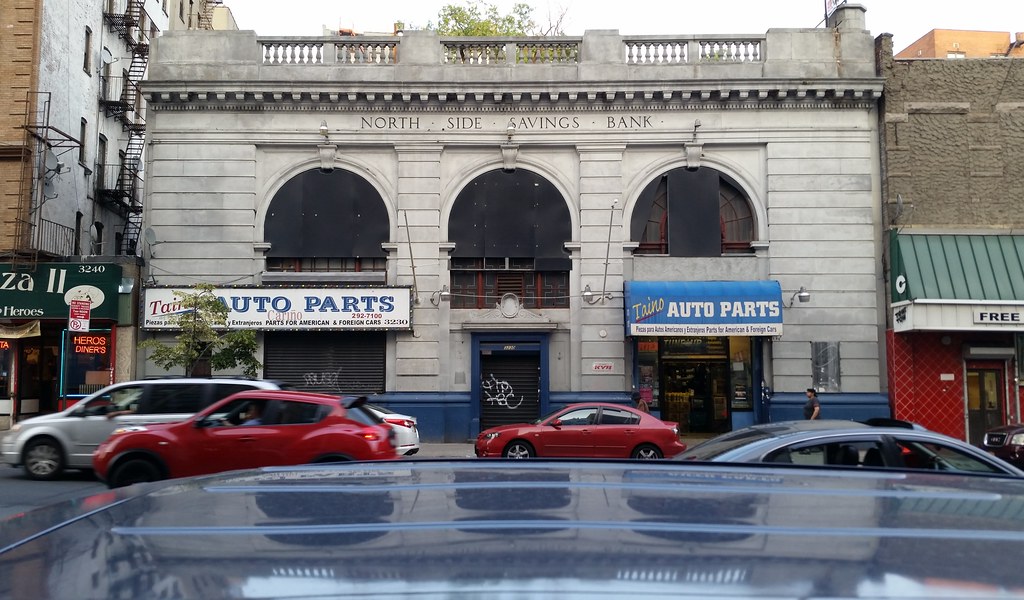
AT NO TIME!
(Photographed on an unofficial stroll through Crown Heights.)
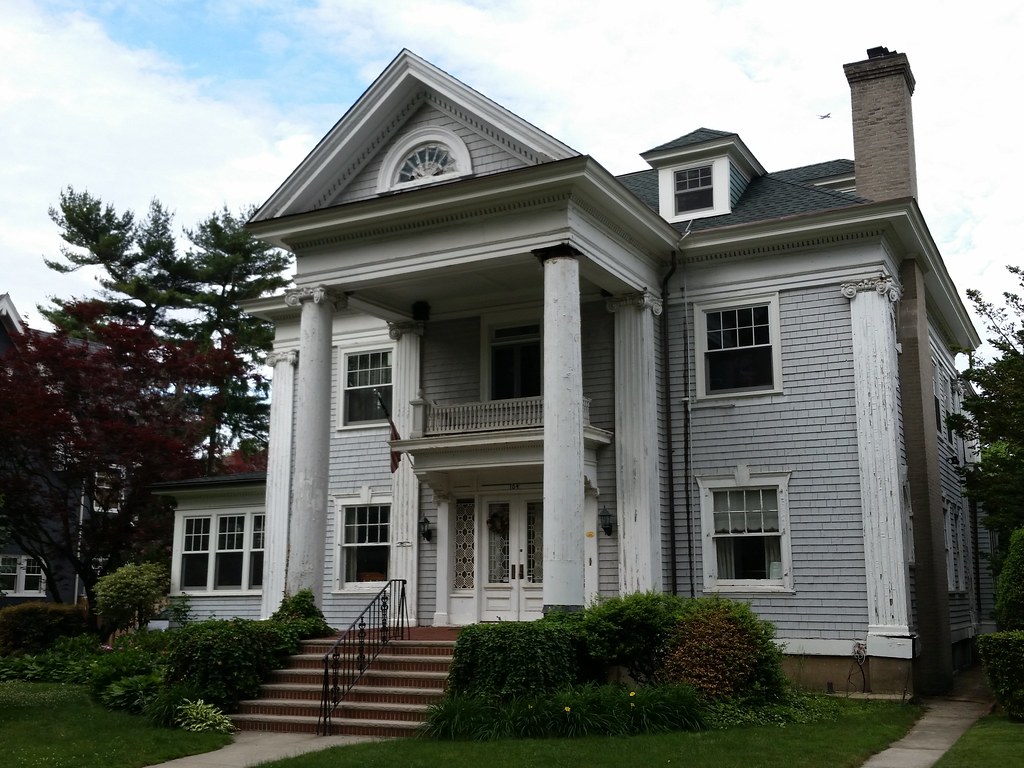
This house, designed in 1901 by Carroll H. Pratt — the architect, not the laugh track pioneer — is one of the many stately dwellings lining the streets of Prospect Park South. The neighborhood originated as a turn-of-the-20th-century suburban community whose developer, Dean Alvord, sought to "illustrate how much of rural beauty can be incorporated within the rectangular limits of the conventional city block." Alvord had the area's numbered streets renamed to sound more aristocratic — East 11th through 16th Streets became Stratford, Westminster, Argyle, Rugby, Marlborough, and Buckingham Roads, respectively — and he required potential buyers to provide references "so as to protect the families of lot purchasers against undesirable social and moral influences."
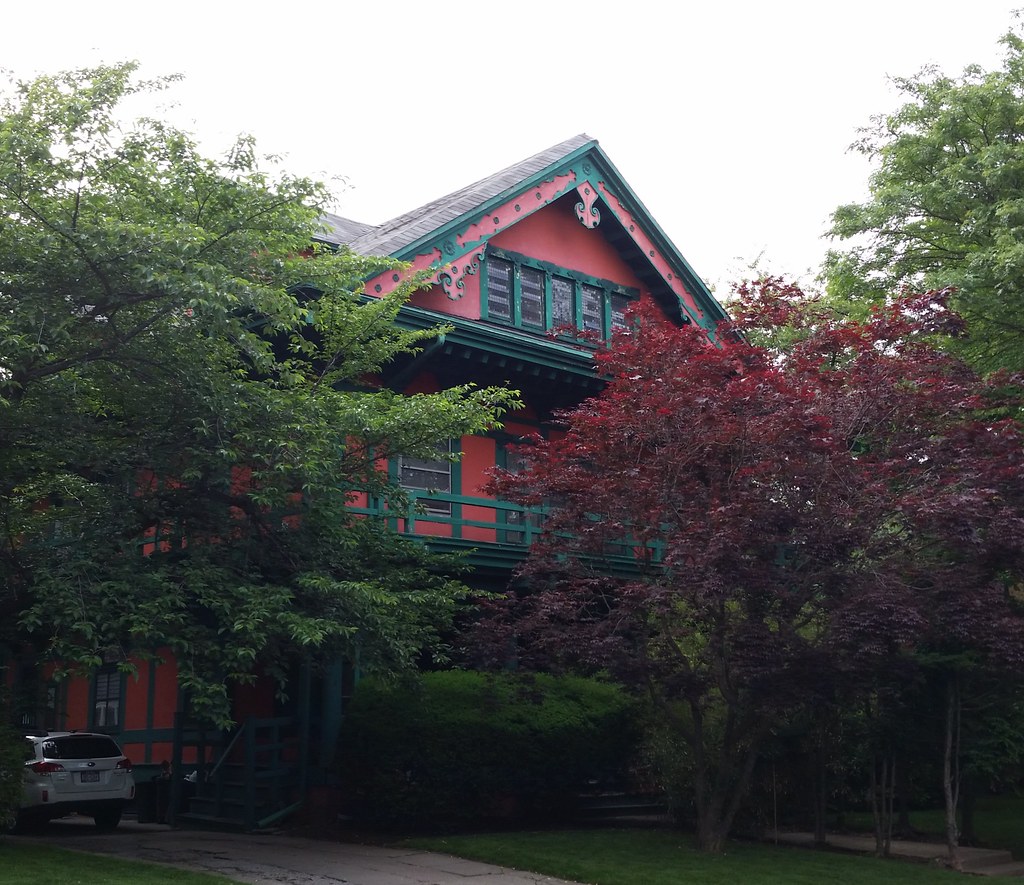
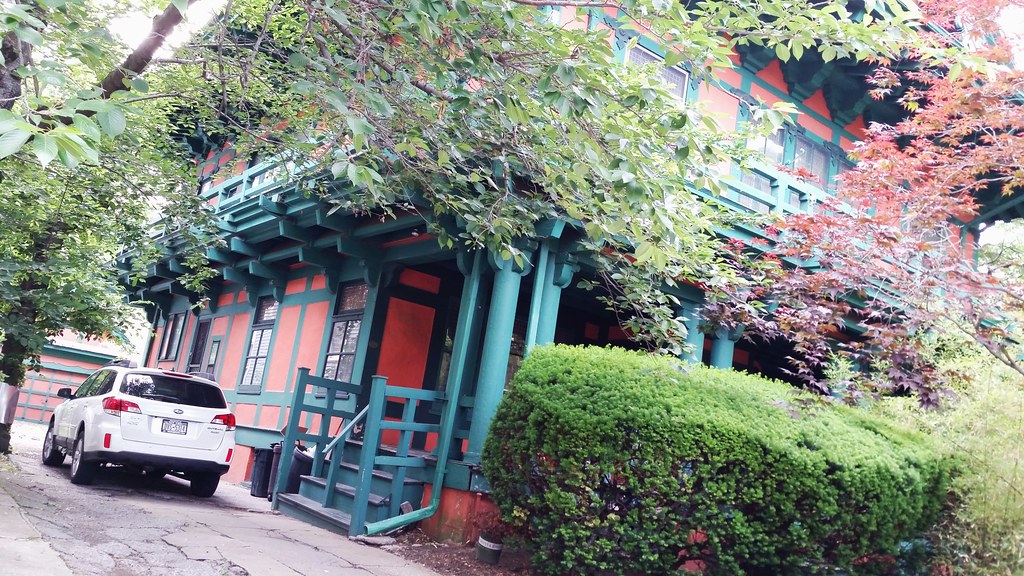
This Japanese-style residence, built in 1902-03, is the "most exotic and certainly the best-known house in Prospect Park South", according to the neighborhood's 1979 historic district designation report. It was designed by John J. Petit, who employed three Japanese artisans to imbue the place with a "genuine oriental quality". You can see more photos of the house here, including many shots of the interior details, which a 1903 ad described as "a faithful reflection of the dainty Japanese art from which America is learning so much."
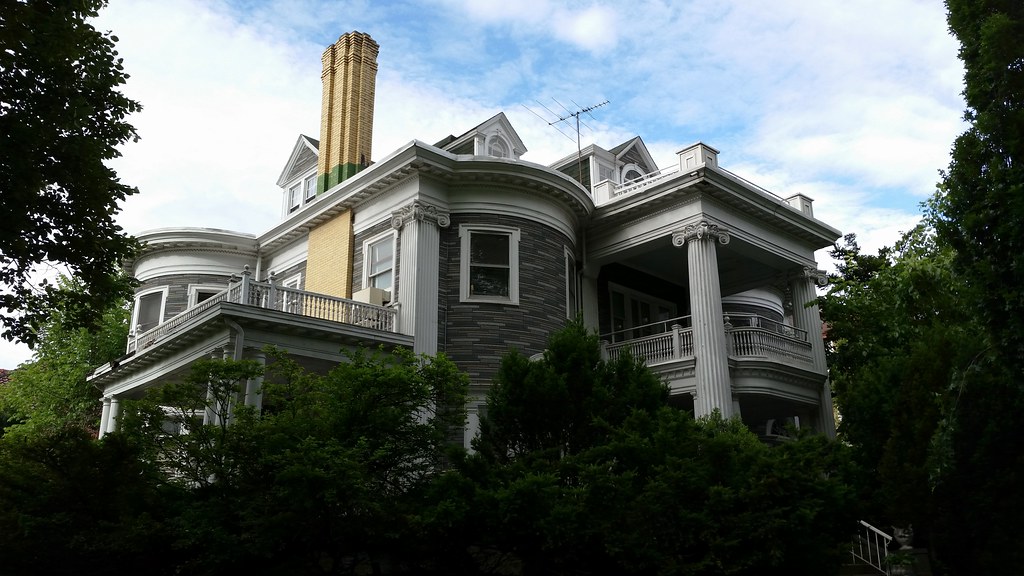
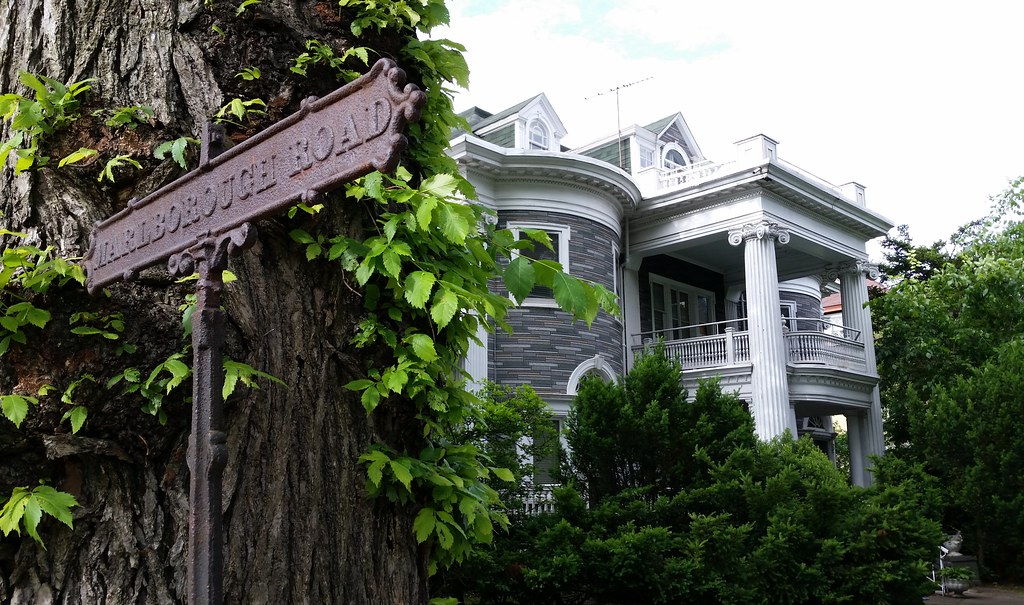
Designed in 1905, this huge Colonial Revival concoction has been covered in asphalt siding for decades. The cast-iron street sign standing at the corner of the lot dates back to the original development of Prospect Park South.
UPDATE: The actress Michelle Williams has purchased this house (interior photos) and intends to fix it up. The Historic Districts Council says of her architect's plans: "The very reasonable and sensitive interventions proposed here, coupled with the removal of the unfortunate asphalt siding, moves this house in the right direction. HDC would like to commend and thank the applicant for this thoughtful proposal."
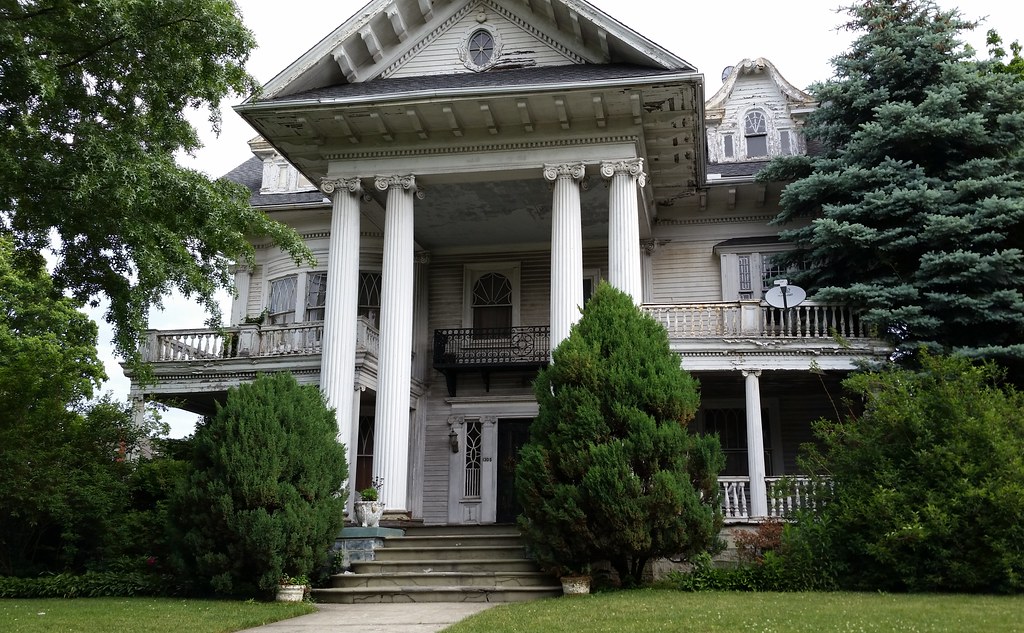
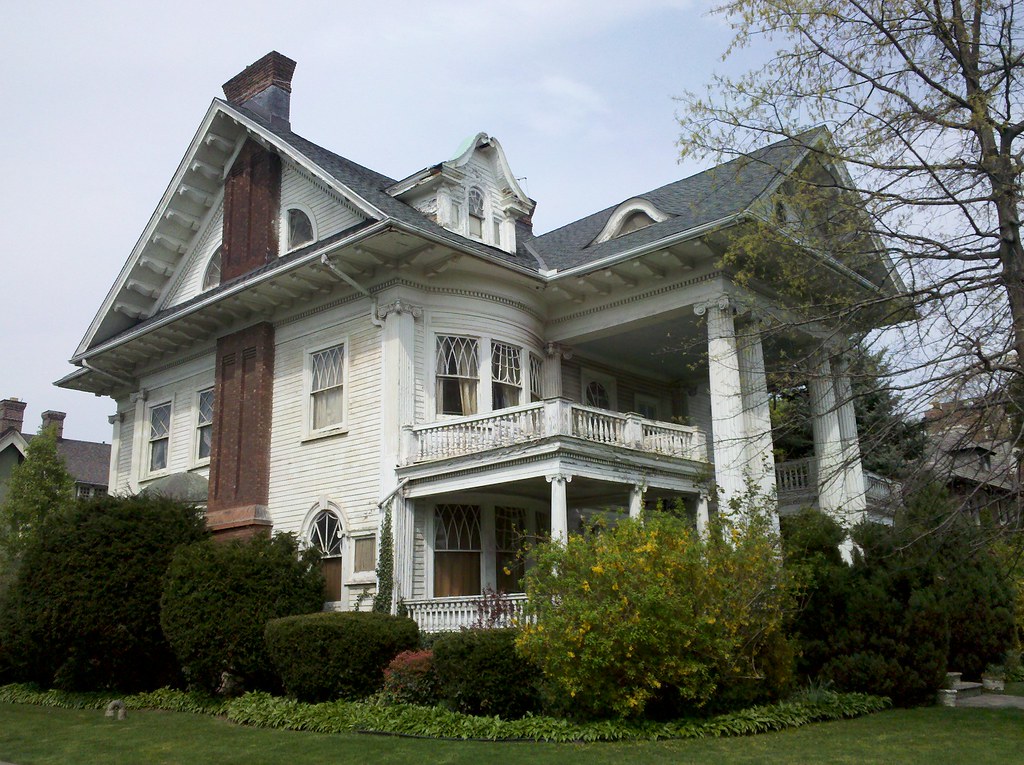
(The lower photo above is from a visit to the neighborhood in 2012 when there were fewer leaves on the trees.)
Here's the architectural historian Christopher Gray's take on this structure:
The most unusual of these dwellings [on Albemarle Road in Prospect Park South] is the one built in 1905 for George E. Gale at 1305 Albemarle, at the northeast corner of Argyle Road, in white clapboard with a colossal two-story Ionic portico. Designed by an architect known only as H. B. Moore, the Gale house has a striking assortment of windows, among them roof dormers with a kind of webbed sash, topped by ebullient broken pediments. On the second floor, there are spider-web-type windows with Gothic-style sashes, and on the rear are leaded glass windows.UPDATE (July 30, 2016): This house was recently sold for $2.98 million. You can see photos of the expansive interior here.
Mr. Moore ran copper cresting in the form of anthemion leaves around the top of a bay window on the side of the house, and he put low, curved eyebrow dormers on either side of the third-floor gable. The Gale house is worth a special trip.
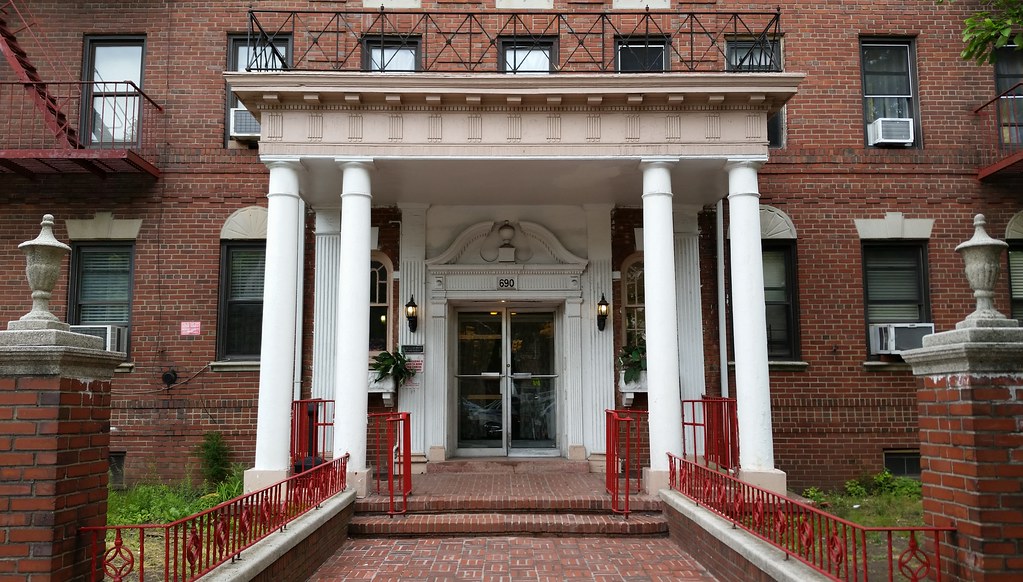
Three items of note from a search for this address in the newspaper archives:
1) 1941: A photo shows Zalman Asher Dunn, a resident of the building and a "tennis star of the Brooklyn College of Pharmacy" (a real athletic powerhouse, I'm sure), providing a woman with "some first-hand information on how to grip a tennis racket".
2) 1945: Vilma Sperling, a 16-year-old professional dancer who lived in the building with her mother, ran off to marry a "wealthy" 36-year-old taxi driver (his mother owned a fleet of cabs). A few hours after their wedding, however, the police arrested the couple at their hotel. Vilma was charged with being a wayward minor, while her husband was charged with abduction and marrying a minor. At his hearing, Vilma testified that she was "terribly" in love with her husband — "who deposited $2,500 in a bank for her and gave her a ring and a fur coat" — and that her mother had demanded a payment of $5,000 if they wanted her consent for the marriage. The charges against the couple were eventually dropped, and while Vilma's mother sought to have the union annulled, Vilma's husband was looking toward the future, telling the press: "No more show business for [Vilma]. She's going to be a real little wife and we'll have lots of kiddies."
3) 1956: George J. Wald, a 34-year-old high school art teacher from the building who had been married twice before, was charged with abduction and rape after eloping with a 17-year-old former student. The girl's parents had him arrested, but her father later relented and asked for the charges to be withdrawn after the couple agreed not to see each other until she turned 18. The district attorney said he would still "submit the matter to the grand jury, but he also indicated that he did not want to stand in the way of 'true love.' "
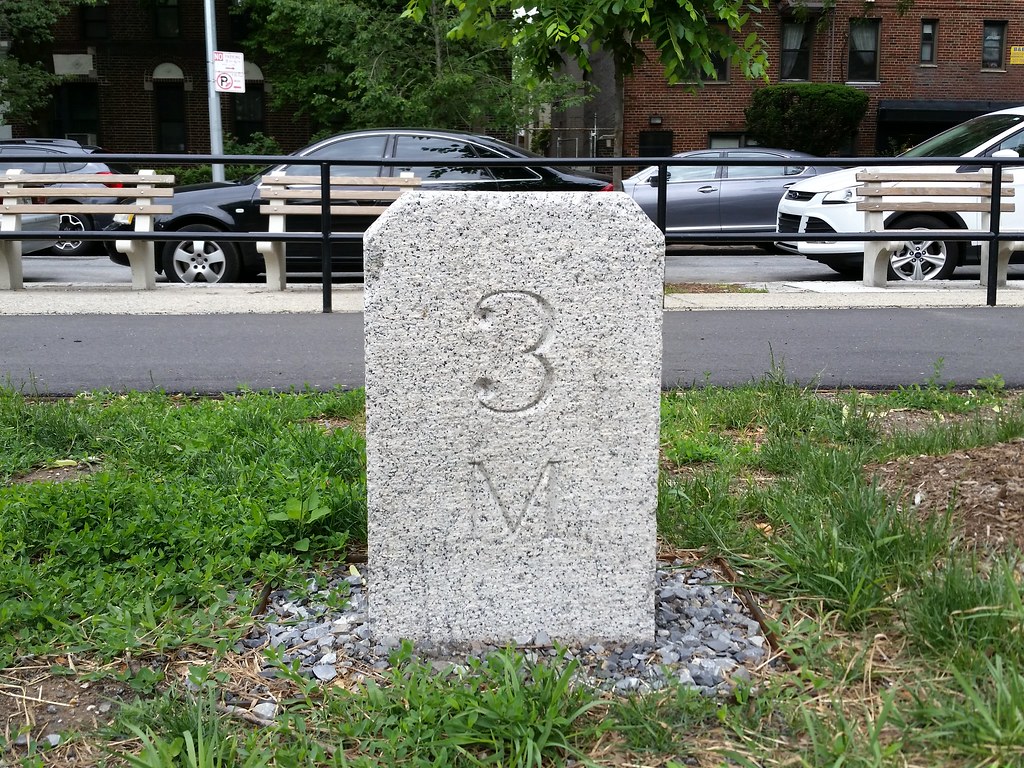
Stones like this one just south of Avenue P were once stationed every half mile on Ocean Parkway, marking the distance along the road's original 5.5-mile route from Prospect Park to the beach at Coney Island. (3M means 3 miles from Prospect Park.) They were probably installed around 1876, the year the parkway was completed.
After the 5M marker was removed several years ago — sometime between November 2007 and September 2009, during which time new concrete was laid over the area where it stood — the 3M stone became the final survivor. It was temporarily removed for restoration while the Ocean Parkway Malls in this area were being reconstructed in 2014, but now it's back home and is even accompanied by a tablet explaining its significance.
In the old days, milestones could be found along a number of prominent thoroughfares in what is now NYC. (You can see a nice collection of photos in this extensive paper on the subject.) Many of the stones have long since vanished, while many others have been relocated to historical institutions for safekeeping (like the one that once stood in Milestone Park). As far as I know, this Ocean Parkway stone is the last one in the city still standing more or less in its original location.
There are four other milestones I'm aware of that are located outdoors in the five boroughs and accessible to the public:
1) A milestone from a section of the Kingsbridge Road that is now part of Broadway can be found embedded in a retaining wall at the edge of Isham Park in Inwood. Likely dating from 1813, the timeworn stone once read "12 Miles from N. York".
2) Another weathered Kingsbridge Road stone is on display outside the Morris-Jumel Mansion in Washington Heights. It too likely dates from 1813, and it read "11 Miles from N. York".
3) A circa-1860 milestone from Jackson Avenue (today's Northern Boulevard) stands outside the Queens Historical Society in Flushing. It bears two inscriptions: "5 MILES TO 34TH STREET FERRY" and "1 MILE TO FLUSHING BRIDGE".
4) A stone reading "6 Miles to N. York F." — 6 miles to New York ferry — is located in front of the Third County Courthouse in Staten Island's Historic Richmond Town. It turns out that this stone is a replica, however. In a phone conversation, the chief curator at Historic Richmond Town told me that it was created in the 1980s and was based on two original milestones that once stood on Richmond Turnpike (today's Victory Boulevard).
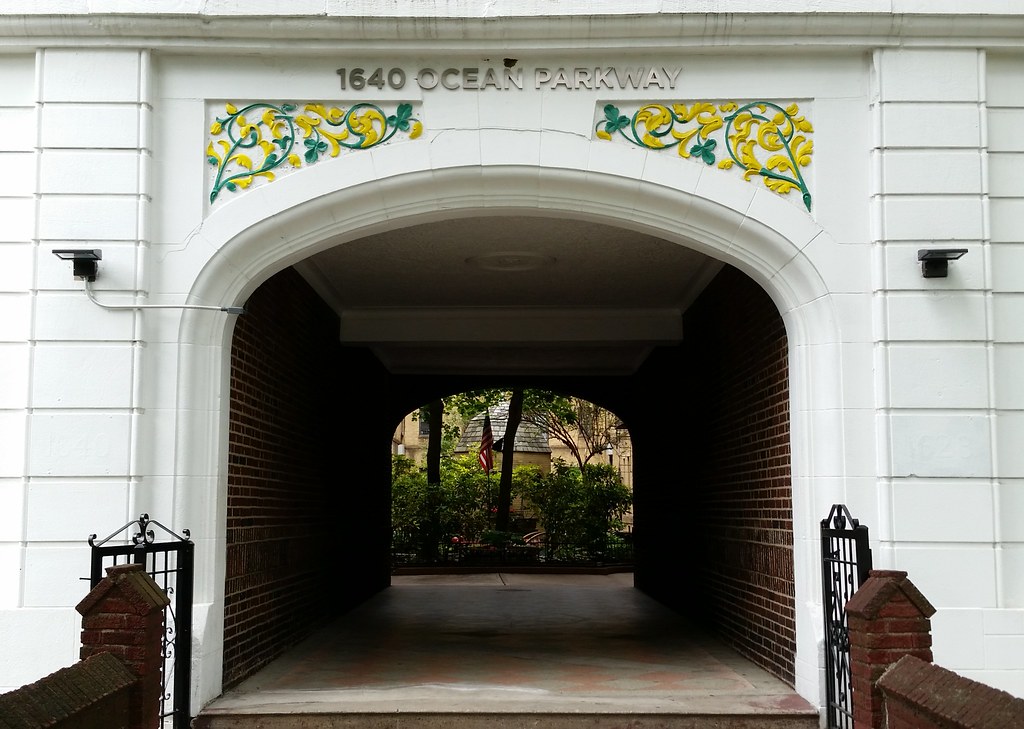
On the morning of January 24, 1929, Raymond B. King, a 30-something-year-old resident of this apartment building, reported to the police that he and his wife had just been robbed in their car in Canarsie. In addition to the vehicle, he said, the perpetrators had stolen around $13,650 worth of money and valuables from the couple.
When he fingered the alleged robbers and tried to press charges, however, his poorly executed scheme quickly crumbled.
Here's what appears to have really happened. Having "squandered" $2,700 that his wealthy father had sent him for business purposes, Mr. King was in need of a story to account for the missing money. So he arranged for two acquaintances from his building, Edward J. Little and Joseph Fitzsimmons, to pretend to rob him while he was out for a drive in a car borrowed from Mr. Little's sister. He brought along a young woman he had met, Mildred Reed, but didn't tell her about the plan, presumably figuring that she could then "honestly" back up his account of the robbery. An added bonus was that, in the course of the holdup, he and his partners could recover the $10 he had given Ms. Reed as a gift earlier in the evening.
Everything went more or less according to plan during the fake holdup. For the sake of authenticity, Mr. King gave the "robbers" $152 and two checks. A frightened Ms. Reed handed over her pocketbook with the $10 in it, and she also threw off her fur coat.
When he reported the robbery to the police, the married Mr. King claimed that Ms. Reed was his wife, and that the bandits had taken $2,450 worth of jewelry and an $1,100 fur coat from her. He also told the cops that, in addition to his "expensive roadster", the men had stolen $2,700 in cash and $7,400 in checks from him.
I suppose the scheme had a chance of working at this point, even though Mr. King was quickly forced to admit that Ms. Reed was not actually his wife. (Did he really think the cops wouldn't find that out?)
But for some reason, while being questioned about the robbers, Mr. King decided to provide the detectives with enough identifying information for them to easily find and arrest Mr. Little and Mr. Fitzsimmons, the last two people you'd think he'd want the cops interrogating. Did he not think pressing charges against his co-conspirators would cause them to turn on him? Did he just assume the police would believe his word without question? And what did he even have to gain here by screwing over his partners — did he think the police would make them give him all their money?
Upon being arrested, of course, Mr. Little and Mr. Fitzsimmons promptly spilled the beans on the whole charade. And then, when the police found the purported $1,100 fur coat that Ms. Reed had been wearing, they discovered it was actually a shabby imitation fur coat, worth no more than $25. Buckling under the weight of his lies, Mr. King folded and admitted the whole thing was a ruse.
So after all that, with their names embarrassingly splashed across the newspapers, the three men ended up arraigned on charges of robbery for stealing $10 and a ragged fake fur coat from Mr. King's fake wife.
Presumably wanting nothing to do with these nogoodniks, Ms. Reed never bothered to appear in court to prosecute them, and so they were turned free. I'm sure Mr. King's real wife was thrilled to see him.
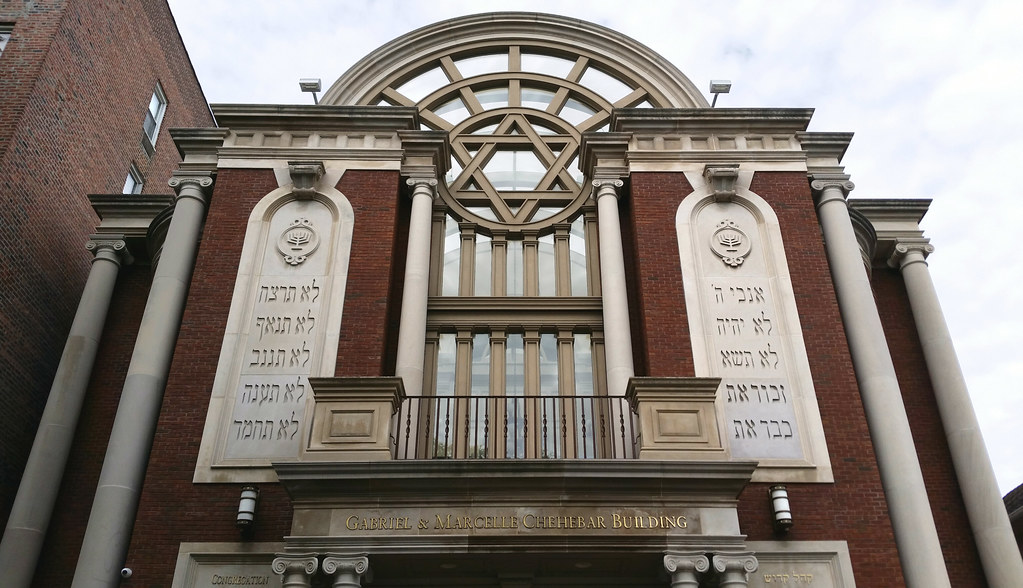
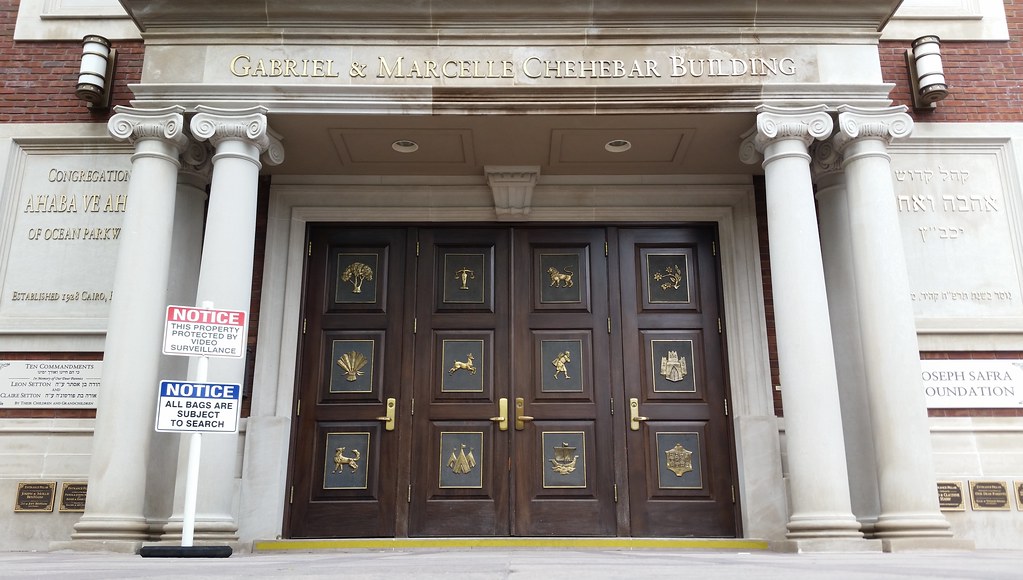
Ahaba Ve Ahva is a congregation of Egyptian Jews. That much I know. The details get a little confusing, though. A panel to the left of the entrance states that the congregation was established in 1928 in Cairo. The Historical Society of Jews from Egypt, an organization formed at the congregation's old synagogue, claims that Ahaba Ve Ahva was established in 1963 in Brooklyn and was the first congregation of Egyptian Jews in the US (scroll down). The congregation's own website says that it was founded in 1979, although that may refer to the year that the congregation first acquired its own building.
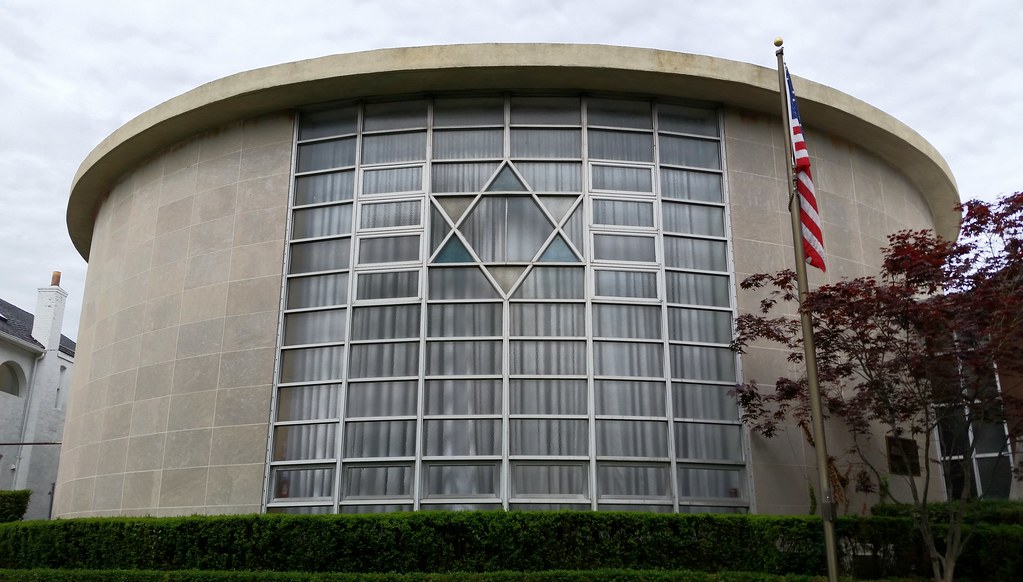
Shaare Zion is the largest synagogue in the "SY Empire" of Brooklyn.

Looks like Mr. Electric Skateboard is headed to the laundromat this time.
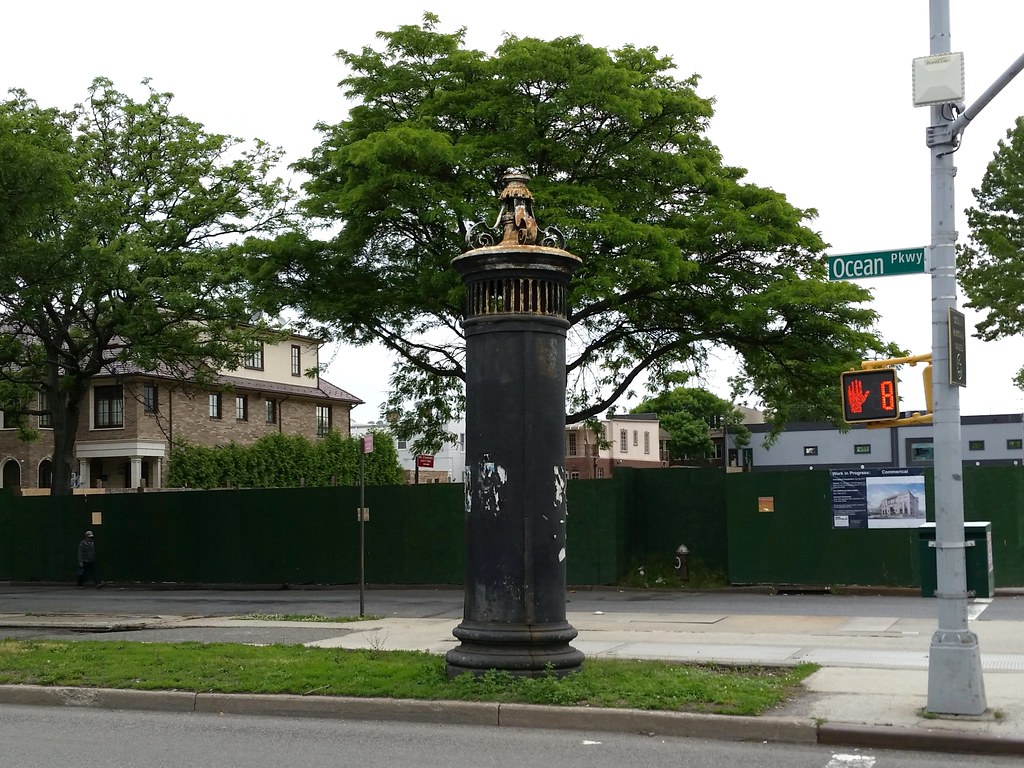
It turns out that this well-coiffed column is a vent for a sewage pumping station located beneath the street. From here, the wastewater heads west toward the largest pumping station in the city, which is housed in a "jewel-like" neo-Classical building at Avenue V and West 11th Street.
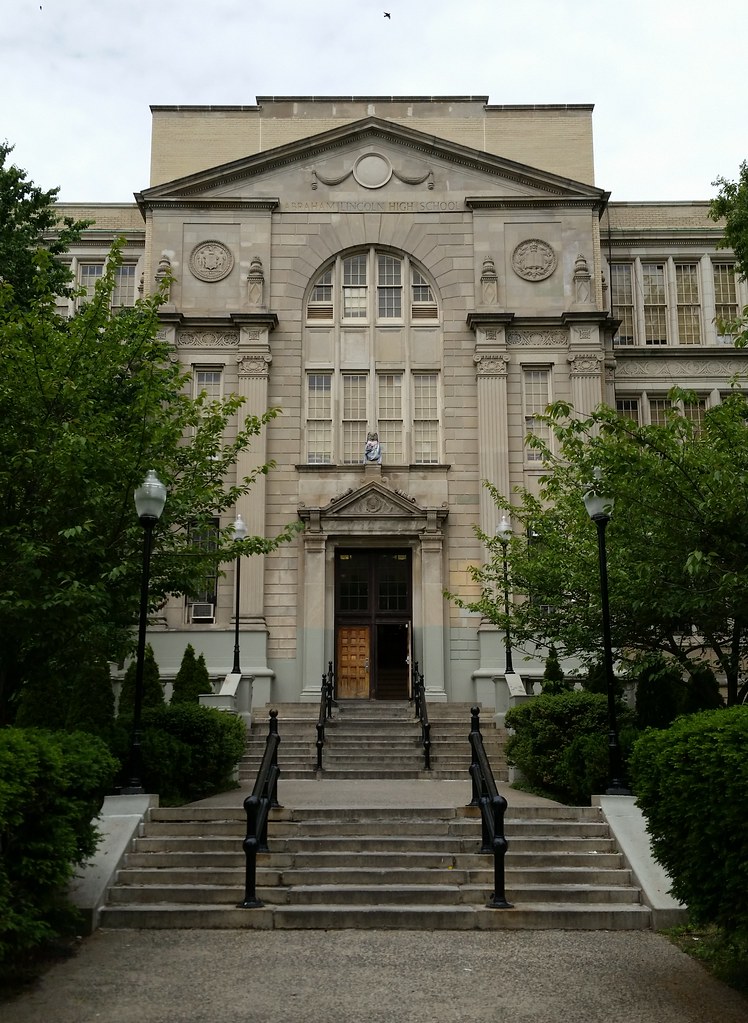
Best known these days for its basketball program, Lincoln boasts a long and diverse list of notable alumni. Among those who attended the school: Nobel-winning scientists (Arthur Kornberg, Paul Berg, Jerome Karle), Academy Award-winning/nominated actors (Lou Gossett Jr., Harvey Keitel), writers whose work you read in high school (Arthur Miller, Joseph Heller), famous musicians named Neil (Diamond, Sedaka), ethically challenged businesspeople (Leona Helmsley, "Crazy Eddie" Antar), the youngest Congresswoman in history until recently (Elizabeth Holtzman), the father of the album cover (Alex Steinweiss), and the architect of cinema's preeminent fart scene (Mel Brooks, who went to Lincoln for his freshman year).
UPDATE: My dad has informed me that his dad, my beloved grandpa Ira, also went to Lincoln! And here's a nice coincidence: Back in 1999, when Ira was really sick near the end of his life, my dad sat down with him and popped Blazing Saddles in the VCR. Ira's mind was going, and he was mostly silent and withdrawn, gazing blankly at the TV screen. He had always been a notorious jokester, but now humor, along with so much else, seemed to elude him. But when the famous eating-beans-around-the-campfire scene (see above) came on, he suddenly lit up — one of the last moments of genuine laughter in a life that had been full of them.
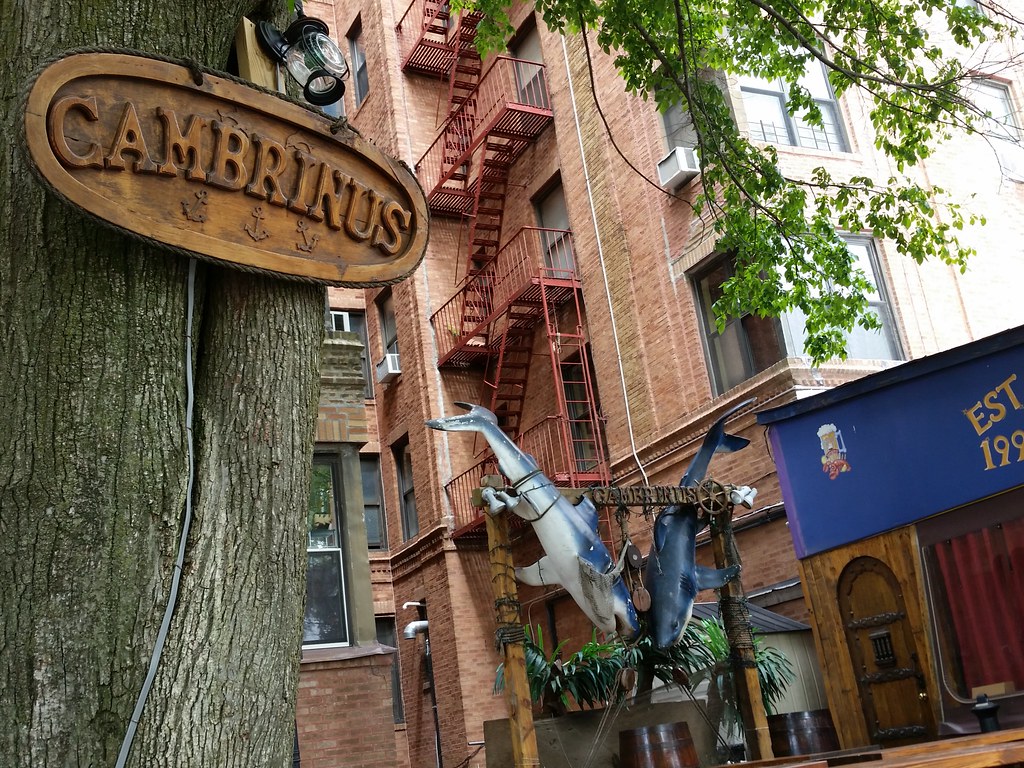
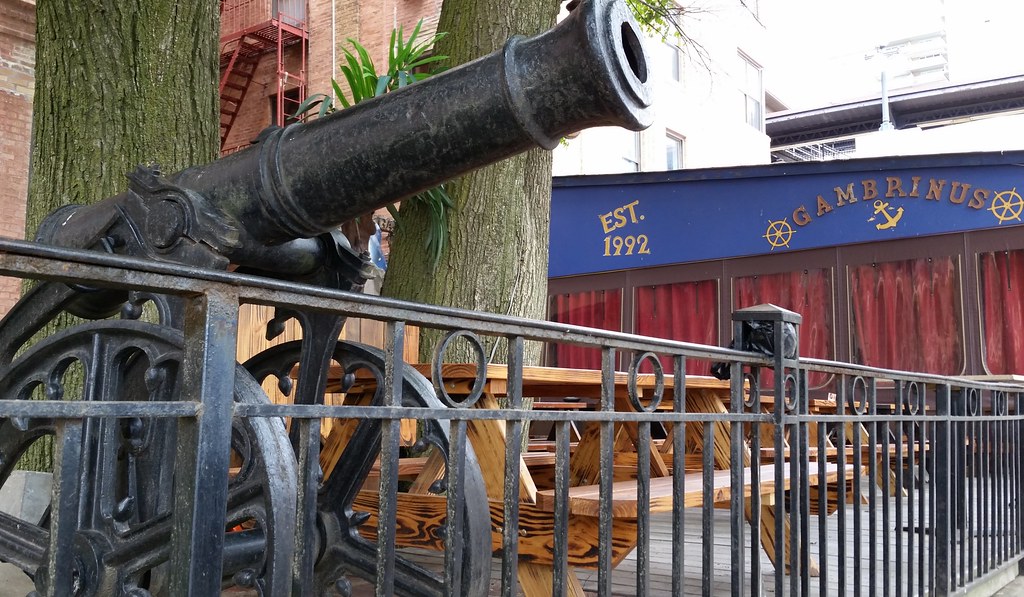
This over-the-top pirate-themed Russian restaurant and beer hall is an homage to a long-standing establishment of the same name in Odessa, Ukraine. The place in Odessa took its name from the legendary beer icon Gambrinus, whom I first learned about when I walked by a big "Gambrinus, King of Beer" statue outside the City Brewing Company in La Crosse, Wisconsin (also home to the "World's Largest Six Pack") back in 2010.
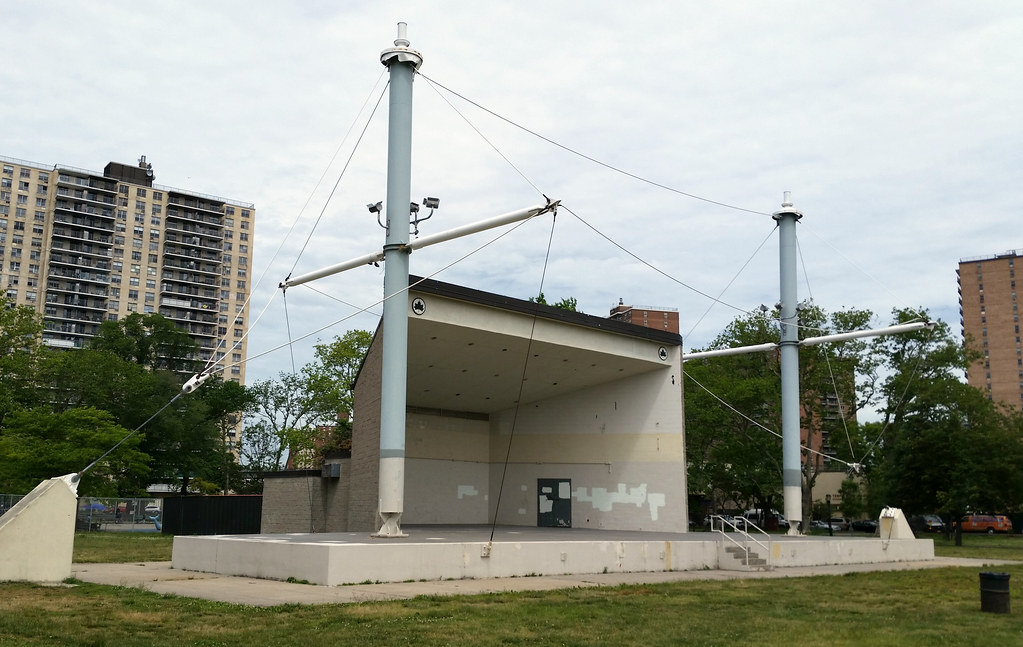
Asser Levy was "the first champion of Jewish rights among the early American colonies" and "probably the first Jewish landowner in North America".
The bandshell in his namesake Coney Island park was for many years the site of the popular Seaside Summer Concert Series put on by former Brooklyn Borough President Marty Markowitz. The concerts gave locals the chance to see some big-name (if perhaps past their prime) musical acts for little or no money — admission to the seating area was $5, while a spot on the lawn was free. But in 2011, a group of local residents, upset by Markowitz's plan to replace the aging bandshell with a large amphitheater, managed to force the shows out of the park altogether. (Some residents are now lamenting the bandshell's decline, as the Parks Department has removed its canopy and is no longer maintaining it as a performance space.)
After a couple of years of holding the Seaside concerts in a parking lot on the east side of the old Childs Restaurant on the boardwalk, Markowitz announced plans in 2013 — his last year as borough president — for the construction of a new amphitheater on the west side of the Childs building, with the stage located inside the to-be-renovated building. The concert series was put on hold in 2014, but should be back on track once the amphitheater is completed.
UPDATE: The Seaside concerts returned in 2015, in the form of a three-day festival held at the Brooklyn Cyclones' ballpark.
UPDATE: The new amphitheater is open for summer 2016 and has a full slate of shows lined up. Of the six concerts that are part of the Seaside series, three are completely free, while the other three are full-price shows with a limited number of free tickets available on a first-come, first-served basis at the box office on the boardwalk starting two days before the show.
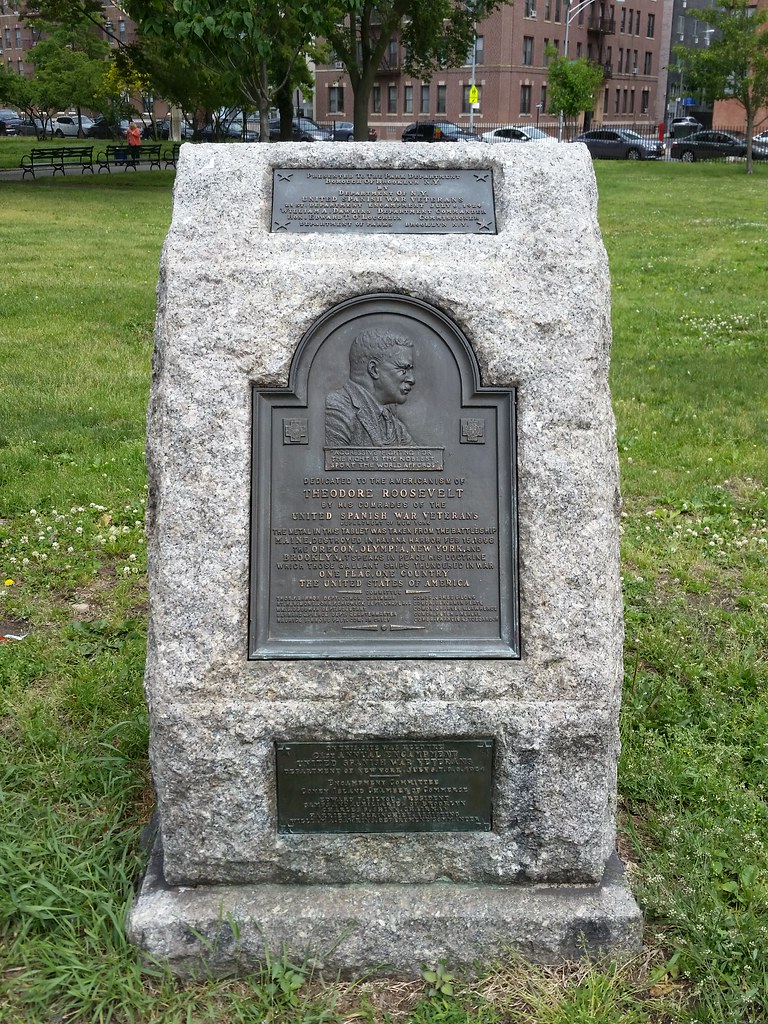
"Dedicated to the Americanism of Theodore Roosevelt", this memorial (close-up) in Asser Levy Park (formerly known as Seaside Park) was unveiled in 1925 by the United Spanish War Veterans' Department of New York, the department having held its 21st annual encampment here in Coney Island the previous year.
The central tablet is made from metal taken from the warships Maine, Oregon, Olympia, New York, and Brooklyn. (The explosion of the Maine in Havana harbor in 1898 was a catalyst for the start of the Spanish-American War, while the Oregon, Olympia, New York, and Brooklyn all served in the war.) The department created the mold for this tablet around 1920 with the intent of presenting a copy to each city that hosted its annual encampment.
(We've previously seen a Maine memorial plaque that was cast from metal recovered from the Maine — as well as a version of that plaque that apparently was not.)

Located where Parkville Avenue crosses Ocean Parkway, this plaque is one of several installed in the parkway malls that feature an alliterative pairing of a sea creature and an intersecting roadway. It's a good bet that the idea for these plaques came from the mind of former Parks Commissioner Henry Stern, an ardent admirer and acclaimed aficionado of animal art and alliteration.
Here's a full list of the Ocean Parkway marine life, from north to south:
- Avenue C Clam
- Cortelyou Cod
- Ditmas Dolphin
- 18th Avenue Anchovies
- Webster Whale
- Newkirk Needlefish
- Lawrence Leatherback
- Parkville Puffer
- Foster Flounder
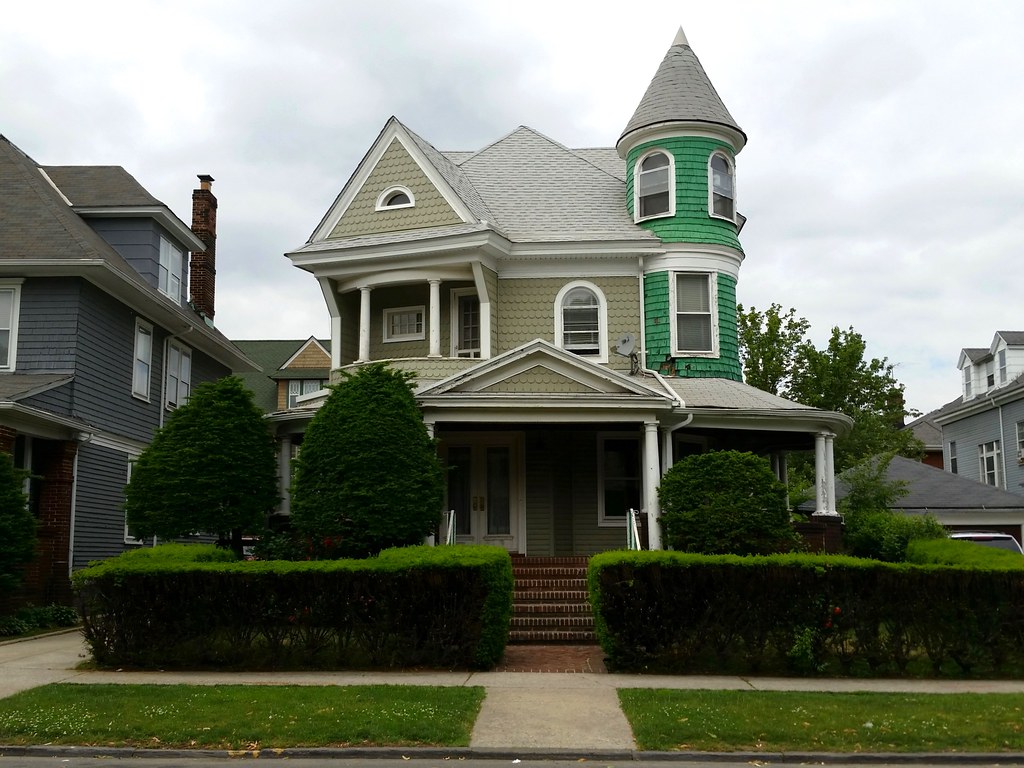
The turret serves as a reminder of what color the entire house used to be.

The plaque to the left of the steps says that this house — 1402 Beverley Road, in Beverley Square West — was built around 1899.
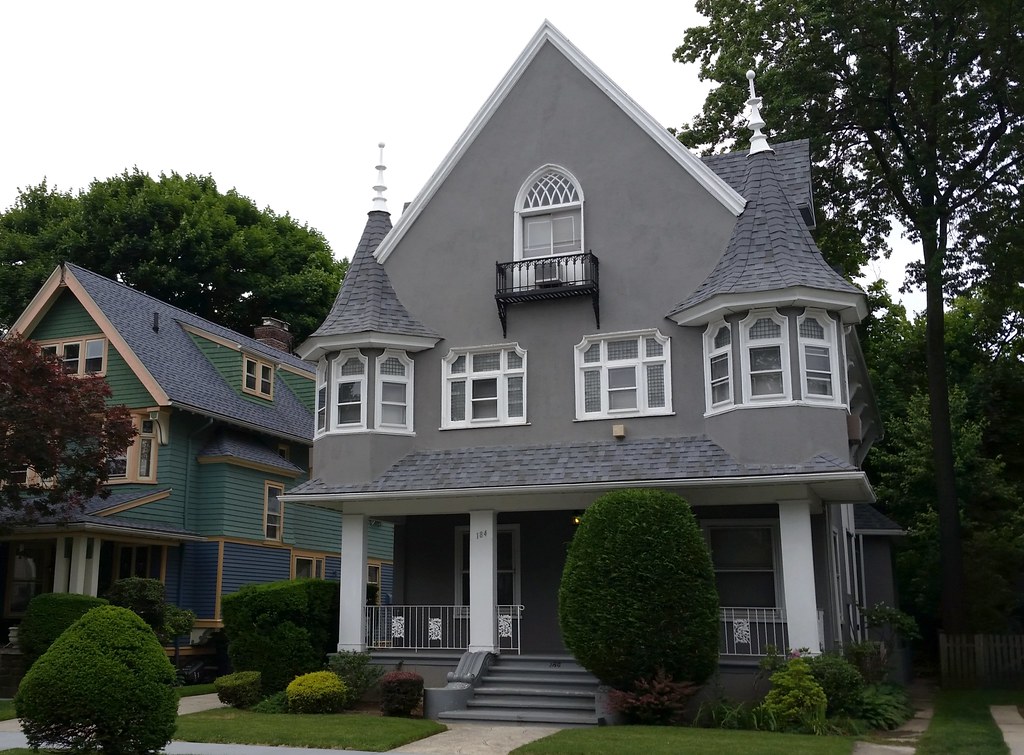
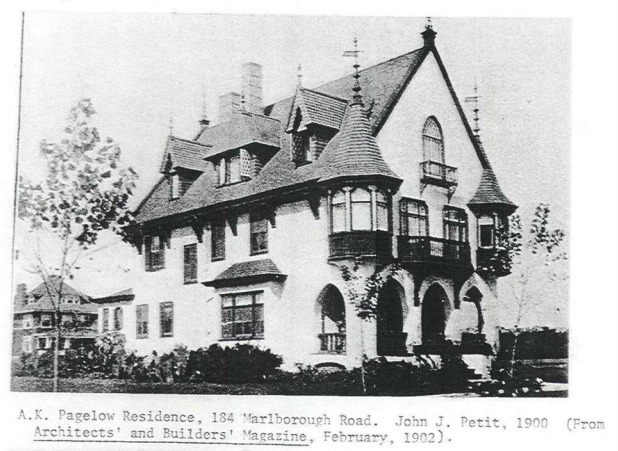
According to neighborhood lore, the renowned journalist and adventurer Nellie Bly once lived in this house. I searched a few newspaper archives and was unable to find any contemporary verification of her residence, but I did come across an account of a bizarre 1919 court case in which Ms. Bly "accused her brother Albert of appropriating machinery used in the manufacture of dental tools." Albert denied the charge and claimed "that his sister had mutilated a portrait of himself that hung in [his] house." Meanwhile, another brother, Harry, alleged that Albert "took a quantity of silk".
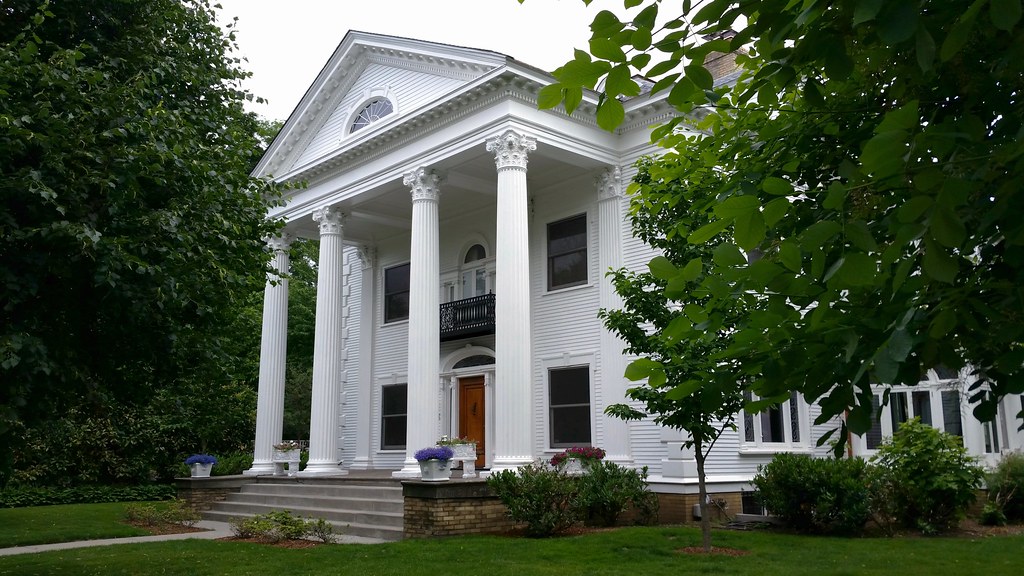
"This beautifully maintained temple-fronted building" is the "grandest of the Colonial Revival houses in Prospect Park South", according to the neighborhood's 1979 historic district designation report. You can see some better photos of the house here.

Using mobile murals, the Royal Kingbee continues to invade new lands.
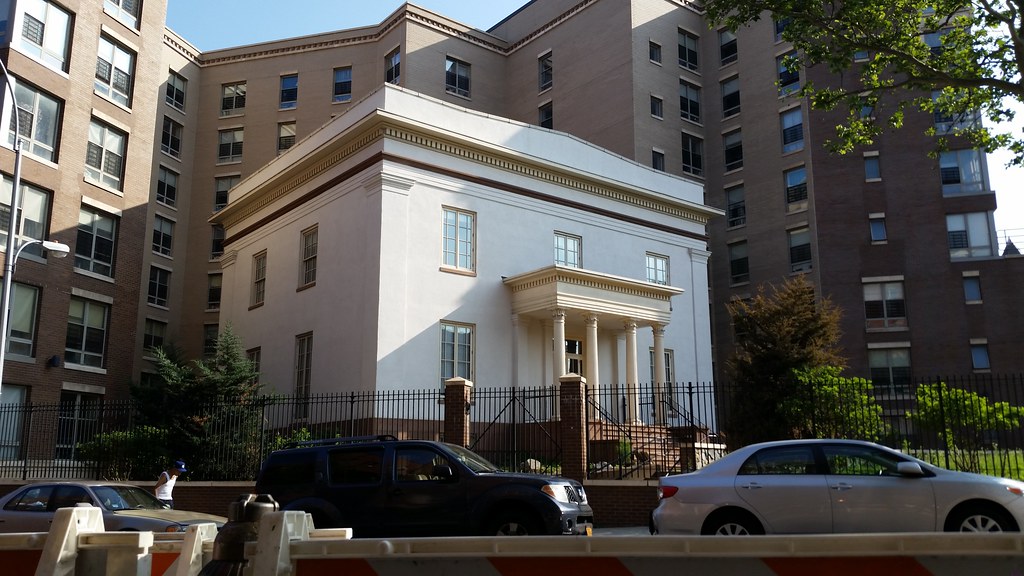
This building, the former Denison-White Mansion, was erected around 1850 by Charles Denison, a Manhattan merchant. It stood on the grounds of his estate, Longwood Park, which was later purchased by his son-in-law, Samuel B. White.
The mansion's residential days, and the area's rural character, came to an end around the turn of the 20th century, when George F. Johnson set up his real estate office in the building and began developing what is now the Longwood Historic District. By 1901, with an extension built onto its south side, the mansion had been redesigned as a clubhouse for the new development. Known as the Longwood Club, it contained "bowling alleys and billiard and reading rooms". The Unity Club and the Martinique Club were later occupants of the building, which would also go on to serve as a Juvenile Service League center and a Police Athletic League facility.
Following a lengthy period of abandonment, the building was in pretty bad shape when a pair of housing non-profits began an extensive restoration/reconstruction effort in 2006 or 2007. (It looks like two exterior walls may be the only surviving pieces of the old structure.) Now called Fox Hall, the building is "the main activity hub and community gathering space at the heart of" Cedars, a 95-unit affordable housing development for low-income and formerly homeless seniors and grandfamilies (grandparents raising their grandchildren).

This vacant building was originally the Prospect Theatre, a vaudeville house that opened in 1910 (postcard image) with a seating capacity of 1,600 (interior photo). Looking through the NY Times archive, I can see that the Prospect was primarily staging Yiddish plays by 1925, and continued to do so until at least late 1934. Based on this photo, I would guess that the theater became a movie house in late '34 or '35 (Twentieth Century was released in '34). A couple of commenters on cinematreasures.org say they remember watching Spanish-language films here between the late '50s and late '60s. It sounds like the place survived until 1986 or so, and then was revived for a few years in the 21st century as the Olympic Theater Concert Hall, a live performance venue.
From the NY Times, February 2, 1914:
Louis Lifschitz, a paper box manufacturer, of 874 Union Avenue, and his wife were about to enter the Prospect Theatre, at Prospect and Westchester Avenues, the Bronx, yesterday afternoon, when Mr. Lifschitz put his hand in his pocket and discovered he had been robbed of $265. Mrs. Lifschitz, on hearing the news promptly fainted. This was too much for Lifschitz. He gave one glance at his wife, and then fell in a faint beside her.
The incident caused much excitement in front of the theatre, and policemen came running from all directions to quiet the throng. An ambulance was summoned from Lebanon Hospital, and Dr. Weinberg of that institution revived Mrs. Lifschitz and her husband. The two then proceeded to the Morrisania Police Station, where Lifschitz reported the robbery.
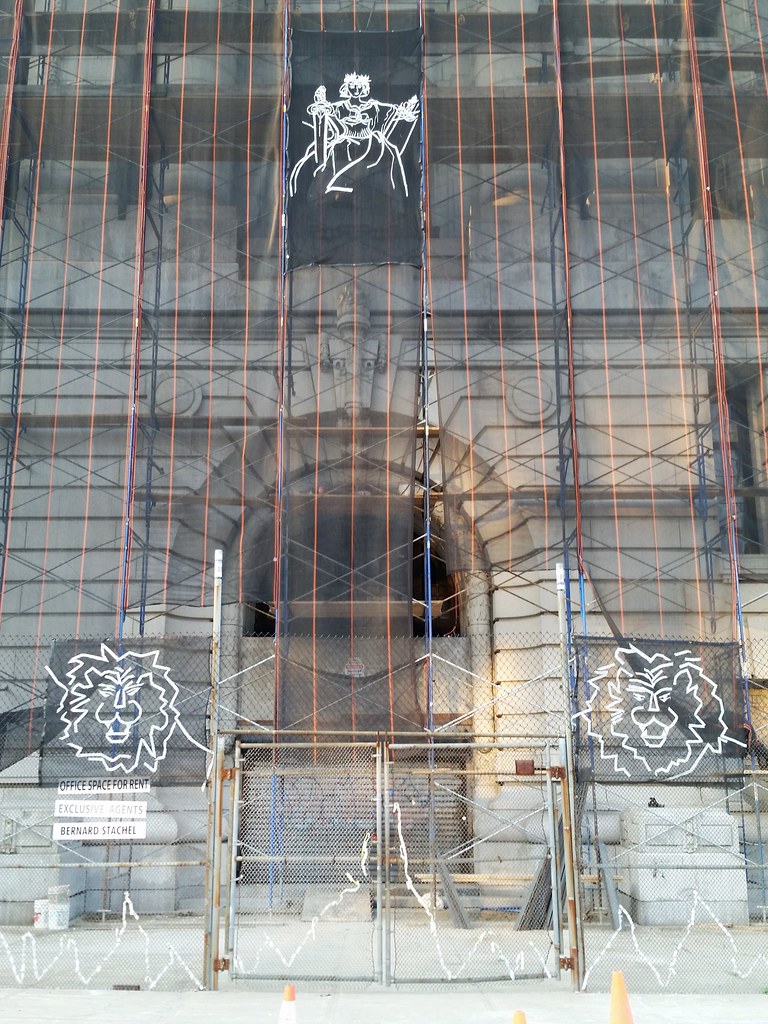
Vacant since 1978, the old Bronx Borough Courthouse is currently undergoing a $10 million renovation. One of the owners hopes to reopen the building by 2017, although he doesn't yet know what it will be used for.
The figures "drawn" on the construction netting are part of an art exhibition that has opened the former courthouse to the public, if only temporarily, for the first time in almost four decades. At the top of the photo is a two-dimensional version of the Lady Justice statue that lies beneath the netting. The two maned lion heads at the bottom made me wonder if the artist was suggesting that lion statues once stood atop the empty pedestals flanking the entrance, à la Patience and Fortitude. This old photo of the building shows that there were no lions, however, but rather what appear to be light fixtures.
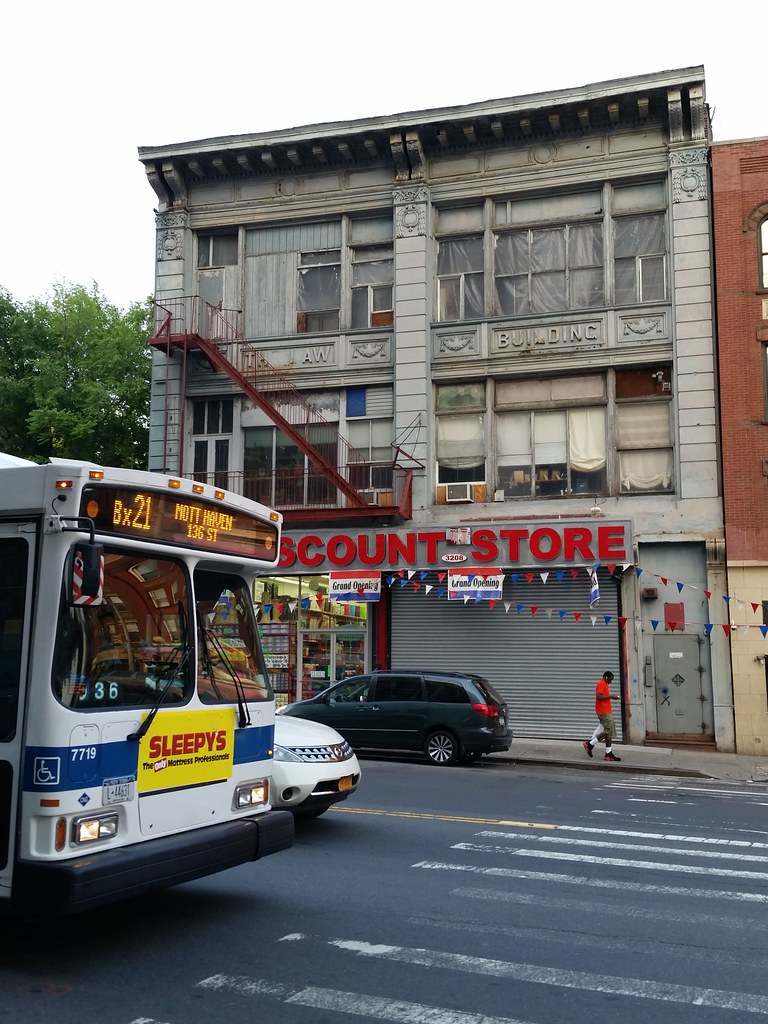
The Law Building, at 3208-3210 Third Avenue, is located across the street from the old Bronx Borough Courthouse. True to its name, the building was formerly occupied by law offices, and was also home to the designated auction room for court-ordered sales of Bronx real estate, not to mention a bakery and restaurant where at least one kid's bar mitzvah reception was held.
One of the lawyers who hung out his shingle here, Edgar Hirschberg, once represented, in the matter of a disputed election, Michael J. Garvin, the "Tammany hack of little knowledge and less repute" who stole credit (and payment) for the design of the aforementioned courthouse from Oscar Bluemner.

After Milciades put on a mini-concert in the casita at the Palmas del Caribe community garden, the guys offered me a couple of Coors Lights and a tour around the garden. You can hear Milciades play another tune, after warming up his pipes, below.
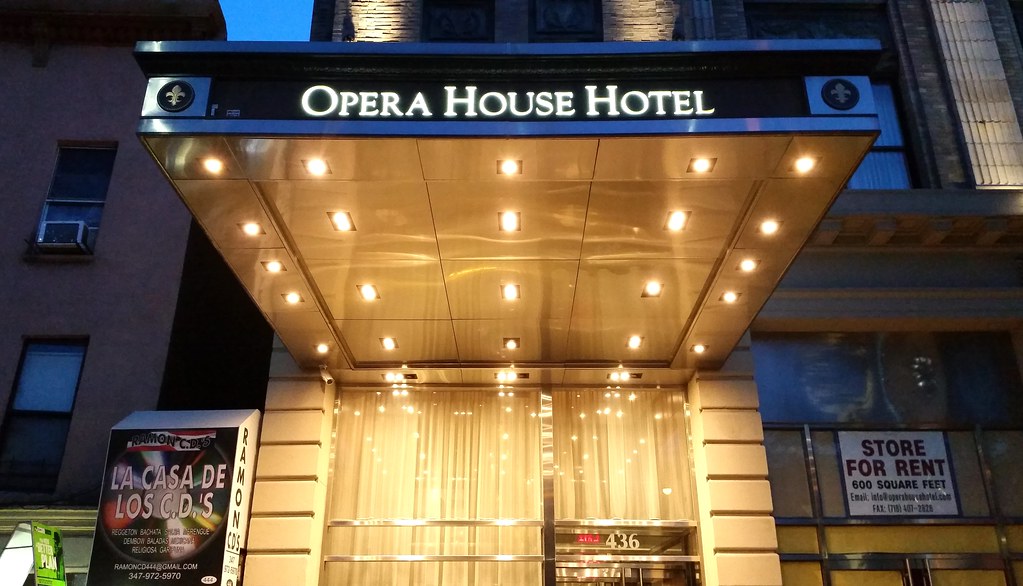
This boutique hotel occupies the former Bronx Opera House. According to the hotel, the old theater "hosted some of the top performers in the history of show business, including Harry Houdini, George Burns, John Bunny, Peggy Wood, John and Lionel Barrymore, and Eddie Cantor."
UPDATE: The Opera House Hotel briefly gained notoriety a couple of months after I walked by when it was determined that the hotel's rooftop cooling tower was the source of an outbreak of Legionnaires' disease that killed 12 people in July and August.

On the wall of this former Rite Aid, the Royal Kingbee is inexplicably bonking himself on the head with a mallet.


